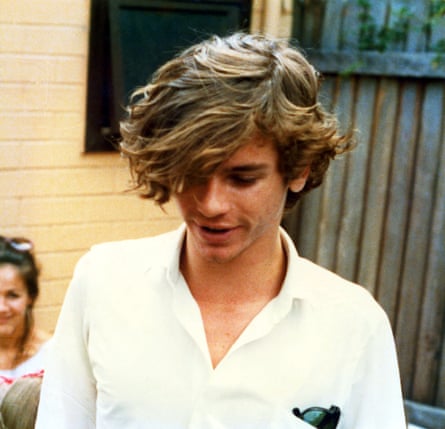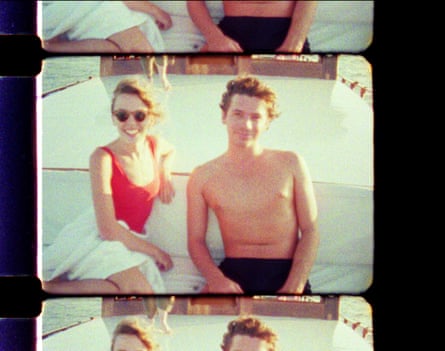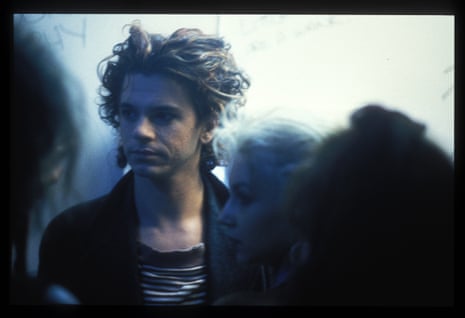Richard Lowenstein’s long-gestating documentary Mystify: Michael Hutchence has finally arrived after a decade in the works. In a sense, the veteran indie auteur has been chipping away at the film even longer than that, since the early days of his career, having directed several music videos for INXS – the Australian rock band the renowned singer-songwriter fronted.
Lowenstein also helmed the endearingly scuzzy 1986 sharehouse drama Dogs in Space. This bong water-soaked, couch-crashing classic features a rare leading performance from Hutchence himself, with whom the director was friends. Lowenstein has described Mystify as an apology for not being there for the late musician, who took his own life in a Sydney hotel room in November 1997.
In this sense, then, it’s no surprise Lowenstein seems to struggle to determine the best narrative hooks with which to frame Hutchence’s story: a case, perhaps, of a film-maker being too close to his material. Mystify is a heavyhearted portrait of a highly talented and complex person, who soared to great heights and plummeted to dreadful lows. How much viewers will get out of it will depend (as is the case with most films about real-life musicians) partly on how much they admire Hutchence going in.

Loads of home footage, clips from performances and a wide range of interviews with people close to the subject make the film a must-see for lovers of INXS. Sadly, it pales in comparison with the director’s other documentaries – including the captivating Autoluminescent: Rowland S Howard and the deeply engrossing Ecco Homo. The latter, which explores the life of another friend and collaborator of Hutchence, the elusive artist Peter Vanessa “Troy” Davies, was inventively framed as part detective story and part freaky eulogy, etched in the post-punk, drug-washed haze of Melbourne circa the 80s.
Davies was not a superstar like Hutchence, so Lowenstein’s challenge involved explaining why his story matters and what this man’s life signified in a broader cultural context. Those elements are lacking in Mystify. From its introductory moments, depicting Hutchence performing Never Tear Us Apart in front of an adoring crowd in a smoky, packed-out venue, there is a sense of reverence and implied genius that runs throughout the film.
Frustratingly, Lowenstein doesn’t let the musician’s talent speak for itself. The film includes snippets of many of his performances, but they are clipped and come and go quickly: a few moments on the stage here and there. I found myself regularly wishing that the director would slow down the pace and let these moments breathe, allowing the audience to savour Hutchence’s vitalising presence and charisma – and, of course, that bewitching voice.

Martin Scorsese included near-complete renditions of several songs in his Bob Dylan documentary, Rolling Thunder Revue. The effect was striking, like a kind of editing room equaliser: allowing rhythm and energy to be momentarily driven by the artist himself, rather than part of the more pressure-packed, chopped-up style of a film like Mystify – a film cut six ways to Sunday.
It finally hits its stride towards the end, when it obtains an interesting journalistic quality. There are some bold suggestions and talking points – including the possibility that Hutchence’s loss of smell (after sustaining a brain injury) increased his sense of a loss of self. Exploring the musician’s relationship with Paula Yates, among several other turbulent aspects of his life, the director makes a point that these types of narratives are never clear-cut; that a person unravelling, in so many areas and with such devastating consequences, entails complex considerations and rarely – if ever – is there a single moral or cut-and-dried perspective.
Lowenstein also makes the bold decision to use audio from interviews with no accompanying images, dislocating what we see and what we hear. This approach has worked to striking effect in several films, including Senna and the electrifying Adam Goodes documentary The Final Quarter. But those films feel very different, more like comprehensively referenced visual essays than, a collection of deeply personal ruminations in a documentary that attempts to distil the essence of a person’s life and character.
When people close to Hutchence forlornly discuss aspects of his life and personality, viewers want to see their faces; we want to fully register their emotions. Interviewees include Kylie Minogue, who reflects on her and Hutchence’s romantic years pursuing a hedonistic lifestyle. Charming home footage shows the two lovebirds on a yacht and then holidaying in Europe, but in this film sadness is never far away. Minogue reflects with melancholy on Hutchence as a broken man, sobbing uncontrollably on all fours. Small but powerful moments, like these, are the ones that stay with you.
